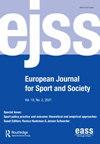ANALYSIS OF HIGH-SPEEDRUNNING AND SPRINT RUNNING IN ELITE FEMALE FOOTBALL COMPETITIONS
IF 1
Q2 HOSPITALITY, LEISURE, SPORT & TOURISM
引用次数: 0
Abstract
Introduction: Although football is recognized as the fastest growing sport globally, scientific literature on female footballis still limited. Available published data in understanding the physical demands of female football players have described the necessity of a high level of physical conditioning during matches with average heart rates of 84-86% maximum heart rate and an average of 9.1-11.9 km in total distance covered in the running. The most commonly utilized physical performance measures reported are high-speed running (19km/h-23km/h) and sprinting (>23 km/h). A better understanding of football's physical, technical and tactical demands has resulted from investigations of both training and matches by wearing a global positioning system unit.Objective: This study aimed to assess the running speed and the proportions of different types of running during official competitions in elite female football players.Material and Method: A total of 22 female players (16 seniors and six juniors) that are part of a Romanian First League female football team -Politehnica Timisoara, have been monitored for running speed and covered distance in 6 official matches, which represent a quarter of the championship period. The assessment period was ten weeks (August-October 2021). The monitored parameters (total distance, distance/minute, low speed running, high speed running, sprint running, and maximum speed) wereobtained using K-Sport GPS with a high sampling rate of 50 Hz.Results: During the six analyzed matches the following average values were found: total covered distance -7906.33 ± 1176.68 m, distance/minute -90.83 ± 3.72 m/min, low-speed running distance-7598.50 ± 1102.16 m, high-speed running distance -308 ± 101.31 m, sprint running distance -69.50 ± 28.54 m, and maximum speed -25.13 ± 0.84 km/h.Conclusion: Regarding the monitored parameters (total distance, average speed, proportion of different speed running, maximum speed), we observed a constancy between different matches. During female football matches, high-speed running and sprinting covered 4.77% of the total distance. Based on this data, a future training objective would be the enhancement of this percentage in order to optimize the key moments of the matches.女子足球精英比赛中高速跑与冲刺跑的分析
导读:虽然足球被公认为全球发展最快的运动,但关于女子足球的科学文献仍然有限。在了解女性足球运动员的身体需求方面,现有的公开数据描述了比赛期间高水平的身体调节的必要性,平均心率为84-86%最大心率,平均跑步总距离为9.1-11.9公里。据报道,最常用的体能指标是高速跑步(19公里/小时-23公里/小时)和短跑(>23公里/小时)。通过佩戴全球定位系统装置对训练和比赛进行调查,更好地了解了足球对身体、技术和战术的要求。目的:探讨优秀女足运动员在正式比赛中的跑步速度及不同类型的跑步比例。材料和方法:在6场正式比赛中,对罗马尼亚第一联赛女子足球队politehnica Timisoara的22名女球员(16名高中生和6名青少年)的跑步速度和奔跑距离进行了监测,这6场比赛占锦标赛期间的四分之一。评估期为10周(2021年8月- 10月)。监测参数(总距离、距离/分钟、低速跑、高速跑、冲刺跑、最大速度)采用K-Sport GPS采集,采样率为50 Hz。结果:在6次分析比赛中,总跑距离为-7906.33±1176.68 m,跑距离/分钟为-90.83±3.72 m/min,低速跑距离为-7598.50±1102.16 m,高速跑距离为-308±101.31 m,冲刺跑距离为-69.50±28.54 m,最高速度为-25.13±0.84 km/h。结论:在监测参数(总距离、平均速度、不同速度跑步比例、最大速度)方面,我们观察到不同匹配之间的一致性。女足比赛中,高速跑、冲刺占总距离的4.77%。基于这些数据,未来的训练目标将是提高这一百分比,以优化比赛的关键时刻。
本文章由计算机程序翻译,如有差异,请以英文原文为准。
求助全文
约1分钟内获得全文
求助全文
来源期刊

European Journal for Sport and Society
HOSPITALITY, LEISURE, SPORT & TOURISM-
CiteScore
3.30
自引率
4.20%
发文量
17
 求助内容:
求助内容: 应助结果提醒方式:
应助结果提醒方式:


